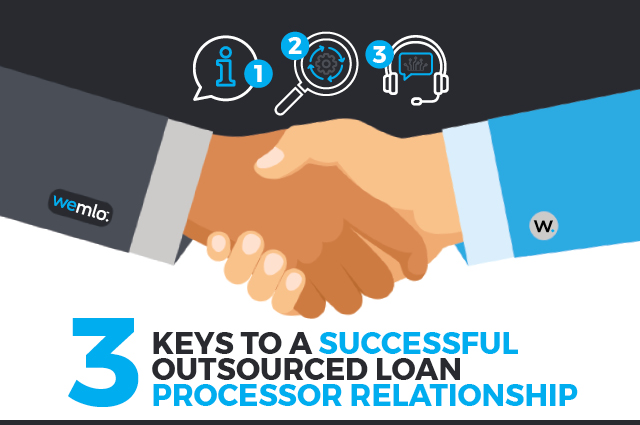New brokers should get to know these consummate professionals. If you’re new to the ranks of the nation’s 25,000+mortgage brokers, odds are you’re still familiarizing yourself...
While some mortgage brokerages have an in-house loan processor, many are looking to third-party processing companies to meet the needs of their growing pipelines. But the home loan process can be a very personal experience for borrowers, and mortgage loan originators (MLOs) may feel cautious about handing them off to an “outsider.” Establishing a positive relationship with your outsourced mortgage loan processor is one of the best ways to make everyone feel more comfortable so that the borrower (and you!) knows they’re in good hands. We talked with Ruth Lee, who has more than 28 years of experience in the mortgage industry and is the operations and sales strategist at wemlo℠, to find out more about how to leverage this relationship so that you can spend less time on paperwork and more time focusing on building a strong rapport with clients, acquiring new clients, and networking within your community.
1. Get as Much Information Upfront as Possible
“It's by far easier to ask for information up front than it is to ask for it about a week before closing,” Lee explains. Getting as much paperwork and information as possible at the beginning of the mortgage process can make for a more seamless handoff while preventing any issues from arising (to an extent, of course). “It is much better for you to tell the borrower as soon as possible that you’re going to need to get, for example, a P&L [profit and loss statement] and a balance sheet because they’re self-employed, rather than waiting for the underwriter to condition it. If you as a processor are able to identify additional documents and work with the borrower to get the necessary paperwork upfront, it really helps in the end,” Lee says. “Some of the best loan officers that I’ve ever worked with did that as much as possible upfront and reviewed their borrower through a processing lens,” which helped head off any potential problems at the origination rather than once the loan moved on to the processor.
The bottom line: Don’t be afraid to ask for more information.
2. Prepare Your Borrower for the Introduction
From day one, introduce the loan processor as a member of the team. The mortgage process is a team effort and everyone is working towards the same goal — getting the borrower(s) into the home of their dreams. According to Lee, this also involves taking the time to walk through the entire process with your borrower(s). “It’s really just saying the next steps in this process are going to be: I'm going to gather up this information and I'm going to turn this over to a processor, and go on exactly through that process map so your client is fully aware of what is coming,” she recommends. “It’s always important to tell somebody what’s going to happen and then explain to them how it’s going to happen — and then finally, reiterate the process. In doing that, I think you set up the processing relationship very well.”
The bottom line: Be transparent about the loan process and all of the team members that will be involved.
3. Technology and Quality Customer Service Have To Work Together
As technology gets more advanced, Lee believes that customer service and communication are even more important. We know that MLOs need to keep an eye on the process while maintaining a high level of customer service from start to finish. With wemlo’s digital processing platform, you can do just that. With a few clicks, you can see any client’s information, the status of any loans, upload documents, and more. “In evolving a processing relationship, communication and having really strong technology where you can communicate is key; however, conveying the story of the borrower to that processor, the context in which that borrower’s loans will be processed as well as submitted and the conditions are done is equally important,” Lee explains.
The bottom line: Effective communication can help make the entire process run much more smoothly. “At the end of the day,” Lee says, “people really want to understand ‘why are you asking me for that?’ or ‘is there a problem with my loan?’ and that doesn’t come from some computer printout, it comes from the human connection that happens throughout the entire process — not only the front-end origination — but through the processing, underwriting, and closing and the borrower feeling comfortable knowing where they are in that whole process and that nothing comes to them as a surprise.”



